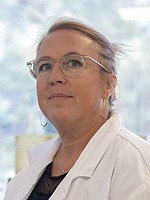Bio-Medical Applications
Session Chairs
Cecile A. Dreiss (Kings College London, UK)
Carsten Werner (Leibniz-Institute of Polymer Research, Dresden, Germany)
Invited Speakers

Liheng Cai (University of Virginia, USA)
Bottlebrush Polymers, Networks, Biomaterials, and Tissue Mimics (shared talk with Advanced Synthesis & New Architectures)
A bottlebrush polymer consists of a long linear backbone densely grafted with many relatively short side chains. In some instances, the bottlebrush backbone can fold to store length, a phenomenon opposite to the prevailing understanding of bottlebrush polymers. Using this so-called foldable bottlebrush polymer as a network strand provides a universal strategy for decoupling stiffness and extensibility of single-network elastomers, the fundamental component of all kinds of polymer networks. Bottlebrush polymers can be used as a platform to engineer modular biomaterials for therapeutic delivery. A voxelated bioprinting technology will be shown for transforming cell-instructive bottlebrush biomaterials into functional 3D tissue mimics for basic and translational biomedicine.

Patricia Dankers (Eindhoven University of Technology, The Netherlands)
Complex tissue-inspired materials based on supramolecular polymers (shared talk with Amphiphilic Gels & Networks)
The integration of synthetic components into biological systems will shape the future of regenerative medicine and drug delivery. In nature, tissues and cells are formed by complex, intricated molecular compositions held together by both covalent and directed non-covalent interactions. They can be regarded as complex molecular systems. The formulation of an artificial extracellular matrix from synthetic building blocks that can assemble and disassemble into supramolecular polymers on demand is proposed to lead to complex tissue-inspired materials. Making use of supramolecular monomers, but also (microfluidic) processing techniques different time and length scales are being addressed.

Stéphanie Descroix (Institute Curie, Paris, France)
Molding and actuating hydrogels for organ on chip development (shared talk with Sensors, Actuators & Responsive Materials)
Organ on chip represents a next generation of in vitro biological models with a great potential in biology, biophysics and clinical application. In this context, mimicking the extracellular matrix composition, architecture as well as the forces experienced by the organ is crucial. In this talk, I will discuss how these different aspects can be implemented on chip to replicate in vivo conditions, and how they can be tuned to investigate their effects on the organ physiology.

Paul Janmey (University of Pennsylvania, USA)
Control of cell and tissue stiffness by filament networks and particle inclusions
Filamentous networks of semiflexible polymers are ubiquitous in biology. Collagen fibers form much of the extracellular matrix, the cytoskeleton controls cell mechanics, and chromatin fibers span the volume of the nucleus. The mechanical properties of the biopolymer fibers, the way in which the fibers link into networks, and the types of cells within the network all affect the way in which tissues respond to mechanical stress.

Nazila Kamaly (Imperial College, London, UK)
Stimuli-Responsive Covalent Nanogels as a Versatile Platform for Drug Delivery
Covalently crosslinked nanogels represent a highly tunable and biocompatible drug delivery platform with the ability to encapsulate sensitive biological therapeutics under mild aqueous conditions. Their chemical versatility enables control over size, charge, porosity, and degradability, while their softness and stability allow efficient delivery even under physiological flow. This talk will highlight advances in stimuli-responsive nanogels and their potential for combination therapies and translational biomedical applications.

Sandra Van Vlierberghe (University of Ghent, Belgium)
Harnessing Light-Curable Chemistry for Superior 3D-printing of Hydrogels Serving Regenerative Medicine (shared talk with Hydrogels & Ionogels)
This talk explores the development of photo-crosslinkable gelatin-based versus polyethylene glycol (PEG) hydrogels to tune mechanical properties and print fidelity for biomedical applications. We compare step-growth and chain-growth polymerization mechanisms highlighting differences in network structure, kinetics, and cytocompatibility. Additionally, the performance of these hydrogels is evaluated in both light-based and extrusion-based 3D (bio)printing platforms to identify optimal crosslinking strategies for each modality.
Contributed talks and posters
... will be continuously added until the abstract acceptance deadline.